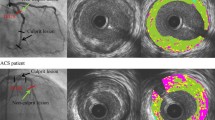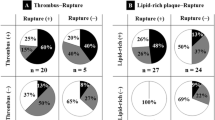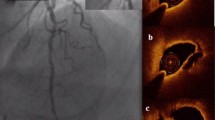Abstract
A comprehensive evaluation of culprit coronary lesions may help to understand vulnerable plaques responsible for ST-segment elevation myocardial infarction (STEMI). We compared intravascular ultrasound (IVUS) and histological findings in culprit coronary plaques from 94 patients with STEMI (n = 54) or stable angina (n = 40). Tissue specimens were obtained by directional coronary atherectomy and IVUS was performed before percutaneous coronary intervention. IVUS and histological data were analyzed. Clinical characteristics were largely similar between the two groups. Plaque rupture and thrombi were more frequently found in the STEMI group than in the stable angina group. There were no significant differences between plaque types or proximal and distal reference measurements in the two groups. However, the site of minimal lumen area had a greater vessel area, remodeling index, and plaque burden with lesser lumen area in the STEMI group than in the stable angina group. Plaque areas immunopositive for CD68 and CD31 were significantly larger in the STEMI group, while the area immunopositive for α-smooth muscle actin was larger in the stable angina group. In conclusion, culprit lesions in STEMI patients showed a greater plaque burden, remodeling index, and more frequent thrombi with increased inflammation and neovascularization compared to the stable angina group, supporting the current concept of vulnerable plaques being responsible for STEMI.


Similar content being viewed by others
References
Schaar JA, Muller JE, Falk E, Virmani R, Fuster V, Serruys PW, Colombo A, Stefanadis C, Ward Casscells S, Moreno PR, Maseri A, van der Steen AF (2003) Terminology for high-risk and vulnerable coronary artery plaques: report of a meeting on the vulnerable plaque, June 17 and 18, Santorini Greece. Eur Heart J 2004(25):1077–1082
Falk E, Shah PK, Fuster V (1995) Coronary plaque disruption. Circulation 92:657–671
van der Wal AC, Becker AE, van der Loos CM, Das PK (1994) Site of intimal rupture or erosion of thrombosed coronary atherosclerotic plaques is characterized by an inflammatory process irrespective of the dominant plaque morphology. Circulation 89:36–44
Libby P (2002) Inflammation in atherosclerosis. Nature 420:868–874
Kolodgie FD, Gold HK, Burke AP, Fowler DR, Kruth HS, Weber DK, Farb A, Guerrero LJ, Hayase M, Kutys R, Narula J, Finn AV, Virmani R (2003) Intraplaquehemorrhage and progression of coronary atheroma. N Engl J Med 349:2316–2325
Khurana R, Simons M, Martin JF, Zachary IC (2005) Role of angiogenesis in cardiovascular disease: a critical appraisal. Circulation 112:1813–1824
Kotani J, Mintz GS, Castagna MT, Pinnow E, Berzingi CO, Bui AB, Pichard AD, Satler LF, Suddath WO, Waksman R, Laird JR Jr, Kent KM, Weissman NJ (2003) Intravascular ultrasound analysis of infarct-related and non-infarct-related arteries in patients who presented with an acute myocardial infarction. Circulation 107:2889–2893
Fujii K, Kobayashi Y, Mintz GS, Takebayashi H, Dangas G, Moussa I, Mehran R, Lansky AJ, Kreps E, Collins M, Colombo A, Stone GW, Leon MB, Moses JW (2003) Intravascular ultrasound assessment of ulcerated ruptured plaques: a comparison of culprit and nonculprit lesions of patients with acute coronary syndromes and lesions in patients without acute coronary syndromes. Circulation 108:2473–2478
Kurisu S, Sato H, Tateishi H, Kawagoe T, Ishihara M, Shimatani Y, Sakai K, Ueda K, Matsuura H (1997) Directional coronary atherectomy for the treatment of acute myocardial infarction. Am Heart J 134:345–350
McKnight J, Studeny M, Roberts G, Touchon R, Wehner P (2001) Directional coronary atherectomy in acute myocardial infarction. W V Med J 97:109–110
Tunstall-Pedoe H, Morrison C, Woodward M, Fitzpatrick B, Watt G (1991) Sex differences in myocardial infarction and coronary deaths in the Scottish MONICA population of Glasgow 1985 to 1991. Presentation, diagnosis, treatment, and 28-day case fatality of 3991 events in men and 1551 events in women. Circulation 1996(93):1981–1992
Nabel EG, Braunwald E (2012) A tale of coronary artery disease and myocardial infarction. N Engl J Med 366:54–63
Burke AP, Farb A, Malcom GT, Liang YH, Smialek J, Virmani R (1997) Coronary risk factors and plaque morphology in men with coronary disease who died suddenly. N Engl J Med 336:1276–1282
Schoenhagen P, Ziada KM, Kapadia SR, Crowe TD, Nissen SE, Tuzcu EM (2000) Extent and direction of arterial remodeling in stable versus unstable coronary syndromes. an intravascular ultrasound study. Circulation 101:598–603
von Birgelen C, Klinkhart W, Mintz GS (2001) Plaque distribution and vascular remodeling of ruptured and nonruptured coronary plaques in the same vessel: an intravascular ultrasound study in vivo. J Am Coll Cardiol 37:1864–1870
Takano M, Mizuno K, Okamatsu K, Yokoyama S, Ohba T, Sakai S (2001) Mechanical and structural characteristics of vulnerable plaques. analysis by coronary angioscopy and intravascular ultrasound. J Am Coll Cardiol 38:99–104
Loree HM, Kamm RD, Stringfellow RG, Lee RT (1992) Effects of fibrous cap thickness on peak circumferential stress in model atherosclerotic vessels. Circ Res 71:850–858
Annex BH, Denning SM, Channon KM, Sketch MH, Stack RS, Morrissey JH, Peters KG (1995) Differential expression of tissue factor protein in directional atherectomy specimens from patients with stable and unstable coronary syndromes. Circulation 91:619–622
Lee CW, Park CS, Hwang I, Lee H, Park DW, Kang SJ, Lee SW, Kim YH, Park SW, Park SJ (2011) Comparison of ruptured coronary plaques in patients with unstable and stable clinical presentation. J Thromb Thrombolysis 32:150–157
Acknowledgments
This study was supported by a grant from the CardioVascular Research Foundation, and the Korea Health 21 R&D Project, Ministry of Health & Welfare, Republic of Korea (H13C1371).
Conflict of interest
None.
Author information
Authors and Affiliations
Corresponding author
Additional information
Cheol Whan Lee and Ilseon Hwang have contributed equally to this paper.
Rights and permissions
About this article
Cite this article
Lee, C.W., Hwang, I., Park, CS. et al. Differences in intravascular ultrasound and histological findings in culprit coronary plaques between ST-segment elevation myocardial infarction and stable angina. J Thromb Thrombolysis 37, 443–449 (2014). https://doi.org/10.1007/s11239-013-0975-z
Published:
Issue Date:
DOI: https://doi.org/10.1007/s11239-013-0975-z




